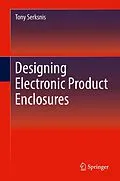This text explains the process of the design of product electronic enclosures. These products typically contain a printed circuit board. The text takes the reader from the original idea for a product, through the shipment in quantity to a customer. For the product enclosure designer, this proceeds through design layout, material selection, prototype building, testing, and ongoing design improvement.
The book presents a substantive and lucid treatment of the structural, thermal, user-interface, assembly, quality control, and cost considerations of the product enclosure. Of special note is a discussion on the regulatory issues involved with the design of a product. A main thrust of the text is on the "commercialization" aspects of electronic products, that is, when an enclosure is needed for the product to meet environmental and certification requirements globally. The book targets the broadest audience tasked to design/manufacture an enclosure, from mechanical/industrial engineers to designers and technicians. While the intent of the text is not to provide a complete understanding of relevant physical phenomena addressed (strength of materials, shock and vibration, heat transfer), the book provides a ready reference on how and where these key properties may be considered in the design of most electronic enclosures.
Elucidates successful enclosure design for electronic products, defining the design team and the definition of success
Autorentext
Tony Serksnis began his career in the drafting room of the Lincoln Electric Company running blueprints in 1964. He apprenticed as a tool and die designer while attending night school. After earning a Master's Degree in Mechanical Engineering from the University of Arizona in 1977, he joined the Material Fabrication Group at Lawrence Livermore National Laboratory. Was a part of the design team that built a precision lathe capable of 0.000001 inch accuracy. He then moved on to positions at Intel Corporation, Sytek Corporation, and Trimble Navigation. While at Trimble, he designed products for the Survey and Construction marketplaces. Later, managed Trimble's Mechanical Engineering Group and was responsible for budgeting, resourcing, prioritization, design and documentation, and project management.
Zusammenfassung
This book explains the design and fabrication of any electronic enclosure that contains a printed circuit board, from original design through materials selection, building and testing, and ongoing design improvement. It presents a thorough and lucid treatment of material physical properties, engineering, and compliance considerations such that readers will understand concerns that exist with a design (structural, environmental, and regulatory) and what is needed to successfully enter the marketplace. To this end, a main thrust of this volume is on the commercialization of electronic products when an enclosure is needed. The book targets the broadest audience tasked with design and manufacture of an enclosure for an electronic product, from mechanical/industrial engineers to designers and technicians. Compiling a wealth of information on relevant physical phenomena (strength of materials, shock and vibration, heat transfer), the book stands as a ready reference on how and where these key properties may be considered in the design of most electronic enclosures.
Inhalt
Introduction and Author's Credentials.- Outline of Text.- Successful Design.- Building the Design.- Structural Considerations.
